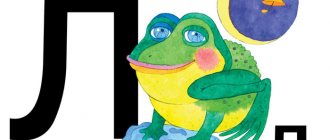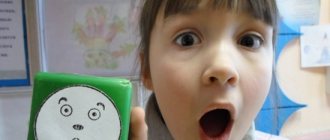Produces a strong and long-lasting air jet
An important role for setting the sound [P] is played by the correct setting of fixed breathing.
A strong, targeted air stream should pass through the articulatory organs. This means that you need to teach your child to breathe and speak correctly at the same time. Often this is not so easy to do. With the help of the following series of exercises, you will understand how to correctly position your tongue followed by the development of a targeted air stream in the middle of the tongue: 1. Place your tongue in the “Pancake” position (see description above) and blow forcefully on it with your voice turned on. When the air vibrates, the tongue will vibrate.
2. “Snowflake”: place a small piece of cotton wool on the tip of your nose and take a deep breath through your nose. Place the tongue in the “Spoon” position (see description above). We press our tongue to the upper lip and forcefully exhale air from the mouth onto the tip of the tongue. A piece of cotton wool should fall off your nose.
3. We bring a scrap or piece of paper to our nose and aspirately pronounce the sound [D]. When pronouncing each sound [D], a piece of paper should be shaken by a strong stream of air.
How to promote speech development in children
From the first months, regularly play animal sounds for your baby and don’t forget about children’s songs. This is great for developing phonemic awareness. Full speech development is impossible without the competent and correct speech of his parents. Every baby always repeats, first of all, after dad and mom. And this is the most important reason to prevent deliberately distorted speech in the form of baby talk. By imitation, children master not only specific sounds, but also a certain style of speech.
Under no circumstances should you start teasing your child, even if he cannot pronounce half the alphabet. He can withdraw into himself, and even the most experienced speech therapist will face considerable difficulties. During homework, do not allow any terror. Either an exciting game, or leave this work for a specialist. The R sound is especially difficult to pronounce for a small person, and be prepared for the fact that it can take anywhere from several weeks to several months to pronounce.
Create interesting stories and dialogues between toys from a very early age, and your child will easily learn to construct sentences correctly. Read children's books aloud regularly. The baby will learn not only new words and correct sound pronunciation, but also learn to understand the general speech structure. And in any case, never forget that he is the best, and everything will definitely work out for him.
Setting the sound [P] from the sound combinations [DR] or [TR]
Children with bilingualism should not try to make the sound [P] by imitation, since they often begin to use a “small tongue” instead of the tip of the tongue (uvular sound [P]), or the root of the tongue that comes into contact with the soft palate (velar sound [P] ). The most effective way to set the sound [P] is to use auxiliary sounds [T] and [D] , which repeat the position of the tongue and the direction of the air. Here are several options for setting the sound [P] using auxiliary sounds:
1. You and your child recall the “Accordion” exercise (see description above), when you attach your tongue to the hard palate and hold it there. Open your mouth well so that the frenulum stretches as much as possible. Using two thumbs, lift the wide edges of the tongue towards the upper lateral teeth (the middle of the tongue and the frenulum remain free). Ask your child to take a deep breath through his nose and forcefully exhale through his mouth with his voice turned on. The child’s tongue should “swell” and you will hear something similar to [TJ]. With repeated repetition and a gradual increase in the pressure of exhaled air, you should hear a combination of sounds [TP]. Make sure that the tip of the tongue vibrates and the edges of the tongue fit snugly against the upper lateral teeth.
2. Mechanical production of the sound [P], which requires a child’s finger or any rounded flat stick. A finger or stick should be placed under the tongue from below (under the tip of the tongue, in no case under the root of the tongue!) and give it an oscillatory movement - from side to side, while simultaneously pronouncing the syllable [T-YOU] or [D-DY] many times in a row . Make sure that your tongue is wide and very tense, and your lips are in a smile. The tongue will swing along with the finger. In this position, you can compare the tongue to a string. If the string is tense, then by touching it we cause it to vibrate. The string begins to sound. But if the string is loose, there will be no sound.
As soon as the child manages to pronounce a combination of sounds correctly and clearly, you can move on to a longer pronunciation of [DR] and [TR] in syllables, words and sentences using your fingers (or a stick) and strong air pressure.
- Syllables: tr-r-a, tr-r-s, tr-r-o, tr-r-u tra-t tra-tru tra-tra tro-tru tro-try tru-try
- Words: grass, ladder, grass, track, cable, touch, troika, labor, tube, difficult
- Words (with emphasis on the syllable): ma-trats, te-trad, ma-tros, me-tro, pa-tron, va-trushka, pe-trushka.
- Sentence: Parsley eats cheesecake. The sailor pulls the cable.
Reasons for the absence of "P"
Speech breathing problems
The direct relationship between breathing and correct speech is very close. If there are no problems, the child inhales through the nose. But for a number of reasons, breathing can become oral or mixed, which leads to deformation of the nasal structure, weakness of the orbicularis oris muscle, and unnatural displacement or drooping of the tongue. Most often, variants of this problem manifest themselves as follows:
- exhalation is intermittent, short, with gradual acceleration;
- breathing is arrhythmic and shallow;
- when inhaling and exhaling, the child twitches his shoulders or head, strongly strains his facial and neck muscles;
- breathing occurs with a delay or additional breaths;
- the child speaks both while exhaling and while inhaling;
- the breathing rhythm is easily lost during emotional or physical stress;
- the air stream is very weak, passes between the edge of the tongue and the cheek, thus creating a squelching sound.
Malocclusion
Anomalies in the relationship between the upper and lower dentition have many causes: from heredity and bad childhood habits to underdevelopment of the jaw muscles and intrauterine pathologies in the mother. The main types of pathological occlusion, due to which sound pronunciation suffers, are:
- prognathic – the upper jaw is strongly shifted forward;
- progenic – the lower jaw moves forward excessively;
- cross – teeth of different sizes, shapes and are displaced in the horizontal plane, the upper or lower jaw is excessively shifted to the left or right;
- open - even with closed teeth, a gap remains between the upper and lower rows.
It is not too late to start correcting your bite at any age, but do not forget that the later the correction begins, the more difficult and lengthy it will be.
Speech hearing impairments
Speech hearing refers to the following natural abilities of a child:
- a sense of the tempo of speech and the ability to reproduce it (rhythmic);
- the ability to accurately recognize and distinguish speech phonemes (phonemic);
- perception of speech melody (sound pitch);
- perception of sounds that differ in sound, volume and pitch (physical);
- the ability to correctly hear and repeat changes in voice timbre (tonal).
To one degree or another, dysfunction of phonemic hearing leads to confusion, replacement, or complete ignoring of P in children's speech.
Insufficient development of the articulatory apparatus
For the production of the sound P, the physiology and condition of the muscles of the tongue, the orbicularis oris muscle, the mobility of the lips, cheeks and even the lower jaw are of great importance. The tongue may be either too large and massive, or, on the contrary, very small, and the lips may be short, thick and inactive. Using simple tests in the form of special exercises, the speech therapist assesses the state of the baby’s articulatory apparatus and selects the most optimal preparatory exercises for setting P in the near future.
Individual structure of the frenulum
A significantly shortened hyoid ligament creates serious obstacles to the mobility of the tongue, thereby automatically leading to defective pronunciation of R. Attentive parents can detect such a pathology on their own by the following signs:
- it is extremely difficult for a child to reach the upper front teeth and palate with the tip of his tongue;
- when asked to show the tongue, its forked, flat or square shape is observed;
- the baby has great difficulty moving the tongue quickly in the mouth from side to side;
- in the process of eating solid food, the child often experiences a gag reflex;
- the pronunciation of L, as well as all voiced and hissing sounds, is unclear.
Automation of sound [P] in syllables and words
Once the long pronunciation of the sound combination [DR] and [TR] has been worked out, you can move on to the isolated pronunciation of the sound [P]. You will hear for yourself that the child begins to pronounce the sound as soon as the tongue muscles get used to the desired position and become stronger. The need to use auxiliary sounds will disappear. If you still hear the use of auxiliary sounds [D] and [T], this means that the muscles of the tongue are not yet sufficiently developed. In this case, continue to perform the previous set of exercises in combination with more careful pronunciation of syllables and words with auxiliary combinations of sounds [D] and [T].
Duration of correctional work
How long does it take to develop the correct pronunciation of the sound R? In modern speech therapy there are no clear time boundaries. This applies to working with any group of sounds. It all depends on the individual characteristics of the child. You can install sound already in the first lessons (if preparatory work has been done), but the automation stage can take quite a long time.
The sound R is complex in articulation, which is why it appears in speech at an older age. There is no need to rush into automation; your task is to achieve clear sound and stable vibration. The tongue should not “slip” when the child pronounces words. To make it interesting for him, use didactic games, and not just verbal and visual material.
You can look for a specific speech therapy technique, but they are all built on the principles and practical tips outlined above. The main condition for successful correctional work is diagnosis and correctional work taking into account the individual characteristics of the child.
Bridle trimming?
A commonly practiced method in the past that I often hear from parents to this day is cutting the hyoid ligament (frenulum). I would like to note that such drastic measures cannot always lead to the desired result - the appearance of the sound [P]. I categorically do not recommend cutting the frenulum unless there is a medical indication for it. The absence of this sound is associated with general weakness of the tongue muscles and underdevelopment of the hyoid ligament. This is why the child is not able to lift his tongue and press it tightly to the palate. Follow the tips above, and the desired results will not keep you waiting.
Good luck to you and your kids!
Speech therapist Alena.
Exercises to improve speech hearing
Game "An Extra Word". The speech therapist calls the child several identical words and among them one that differs in sound. The child’s task is to clap his hands or stamp his foot on the extra word. For example, saffron milk cap - saffron milk saffron - saffron milk cap - saffron milk cap, growls - growls - growls - hums, rum - rum - house - rum, work - work - care - work, cat - cat - cat - crust, etc.
The same thing, but with syllables: ra-ra-ra-pa, ro-ro-lo-ro, ry-ry-by-ry, etc.
Game "Let's feed the bunny deliciously." In front of the child is a toy hare and a set of pictures with images of products. The bunny needs to be offered everything edible, the name of which has the sound R. An approximate set of illustrated cards: carrots, grapes, bread, cake, tomato, cabbage, apple, pear.
A game with a ball, during which the child catches the ball if the speech therapist names a word with the sound R and discards it if there is no P in the word.










